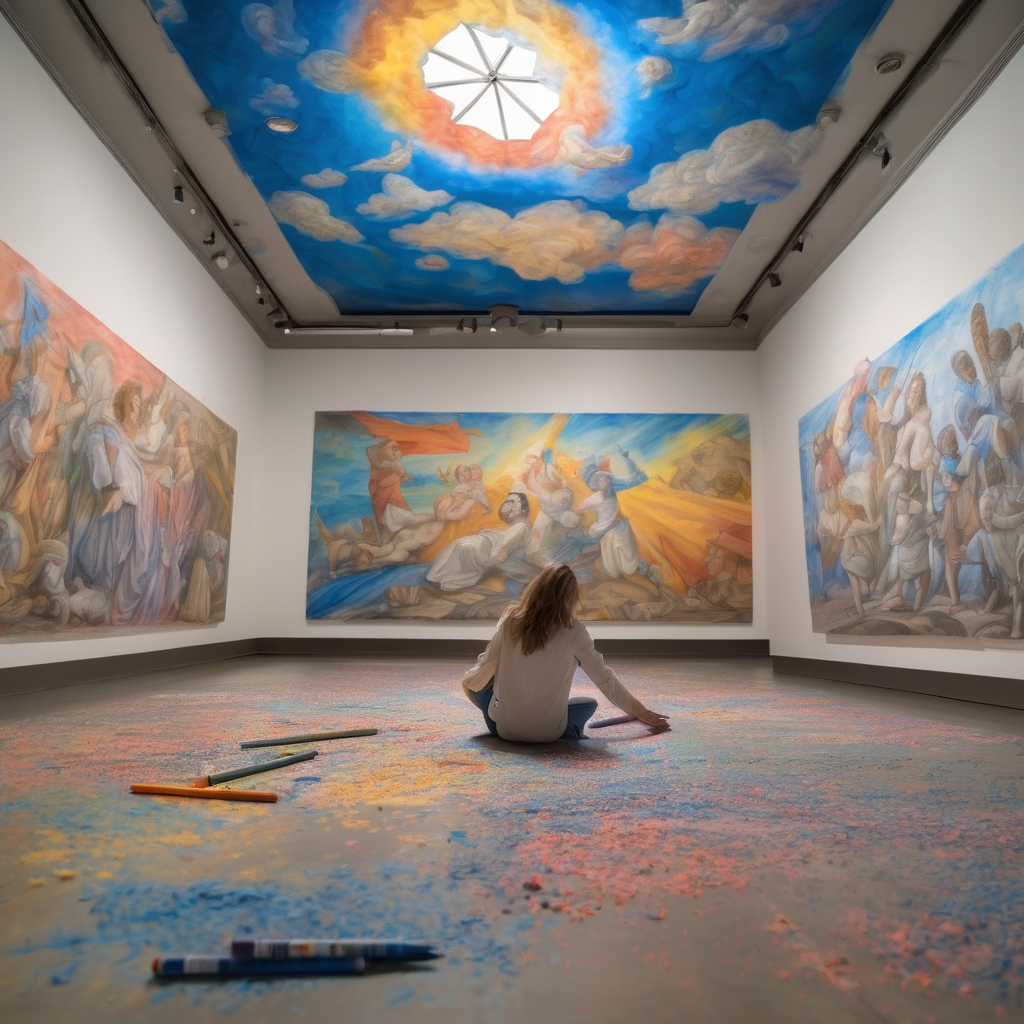The museum guard found Esmeralda’s body beside the unfinished mural at dawn, her fingers still wrapped around a stub of cerulean crayon. The wall displayed what would become the most controversial piece in modern art history: a vast landscape where Renaissance cherubs played volleyball with sustainable energy windmills, while a baroque-styled figure in designer sneakers conducted an orchestra of melting clocks.
Detective Marina Voss arrived as the forensics team photographed the scene. The victim was Esmeralda Thorne, the guerrilla artist who’d spent the last decade breaking into museums worldwide, leaving behind impossible additions to famous works. She’d once added a tiny door to Vermeer’s Girl with a Pearl Earring that, when examined closely, revealed an entire miniature world inside—complete with its own stock market crash and recovery, all rendered in Crayola.
“She was working on something called ‘The Convergence,’” the guard explained, still shaking. “Been coming here legally for once, special commission. Said she needed to finish before Mercury went into retrograde.”
Marina studied the wall. The crayoned mural seemed to pulse with impossible depth. In one corner, medieval plague doctors distributed vaccines made of stardust. In another, a Renaissance banker calculated carbon credits on an abacus while his pet phoenix underwent a sustainability audit. The whole piece felt alive, like watching history have a fever dream about its own future.
“Look at this,” the forensics photographer whispered, zooming in on a section near Esmeralda’s hand. There, barely visible, was a figure that looked exactly like Marina herself, drawn in profile, examining a crime scene within the crime scene, infinite recursion in waxy primary colors.
Marina’s phone buzzed with her horoscope app: “Today you will discover that some boundaries are meant to be crossed, but only with the right medium.”
The curator, Dr. Helen Marsh, arrived looking disheveled. “She insisted on crayons,” she said. “We offered her any medium—oils, holographic projection, even that new bio-luminescent algae paint. But she said crayons were the only thing that could hold what she was trying to capture. Something about their honest chemistry, their childhood immunity to market speculation.”
As Marina questioned witnesses, she learned Esmeralda had been acting strangely for weeks. She’d been talking about “the thinning,” how certain moments in history were wearing through like old fabric, letting other times bleed through. She claimed she could see the stock prices of tulips from 1637 superimposed over modern cryptocurrency charts, could hear Victorian chimney sweeps discussing climate change.
The toxicology report came back clean, but the coroner noted something odd: Esmeralda’s fingerprints had changed. Not just worn down—transformed. They now contained tiny, perfect spirals that matched the patterns in her mural, as if she’d been drawing herself into her own work.
Marina returned to the mural that evening, alone. The museum was closed, the space lit only by emergency exits. As she stared at the wall, she noticed something she’d missed before: a section that wasn’t quite finished, where Esmeralda had been working when she died. It showed a classroom, children drawing with crayons, but their papers contained complex economic models, climate data, social media algorithms—all rendered in the simple, bold strokes of childhood art.
In the center of this unfinished section was a single word, written in every color at once: “SUSTAINABLE.”
Marina reached out to touch it and felt warmth. The crayon was still soft, as if just applied. She pulled her hand back to find a smear of color on her fingertip—not just on the skin, but somehow under it, part of it.
The security footage, when she finally reviewed it, showed Esmeralda working frantically through the night, but in the final hour, she wasn’t alone. The camera captured shapes moving in and out of the mural—figures from different eras stepping through the wall to hand her crayons, whispering in languages both dead and not yet born. A Victorian child teaching her about supply chain logistics. A medieval merchant explaining social media engagement. A figure from no recognizable time at all, dressed in clothes that seemed to be made of condensed aurora borealis, guiding her hand as she drew.
At 3:47 AM, Esmeralda had stood back, smiled, and said clearly to the camera: “The forecast calls for transformation. High pressure systems of change moving in from all timelines simultaneously.”
Then she’d sat down against the wall, closed her eyes, and simply stopped.
Marina filed her report as death by natural causes, though she knew no one would believe what she’d seen in that footage. The mural was preserved behind climate-controlled glass, becoming the museum’s most visited and most mysterious piece.
Visitors often reported strange experiences: economists seeing their models restructure themselves into playground games, climate scientists finding solutions hidden in the scribbles, children drawing on the provided paper with museum crayons only to create perfect recreations of Renaissance masterpieces they’d never seen.
Marina kept the colored smear on her fingertip. It never washed off, never faded. Sometimes, late at night, it would warm, and she’d know somewhere, in some museum she’d never visited, another guerrilla artist was picking up their first crayon, ready to draw the impossible into being.

Leave a Reply